FCC Resolves MSS ex parte Complaint:
Continues 30+ year inability to find violations
But, MSTV has actually improved compliance in the process!
But, MSTV has actually improved compliance in the process!
We reiterate the tentative conclusion in the Notice that stricter enforcement
of our ex parte rules complements the improvements to the rules we are
adopting today and reinforces their purpose in making our proceedings
more open and transparent to the public and fairer to
interested parties. -- R&O&FNPRM, Docket 10-43 2/2/11
On August 25, 2008, Marcus Spectrum Solutions filed a Petition for Review with FCC dealing with the rejection by OGC of a previous complaint complaint about MSTV’s apparent violation of the Commission’s ex parte rules.
905 days later, on February 16, 2011, the Commission released a Memorandum Opinion and Order (MO&O) denying the application for review. The MO&O was thus released 2 weeks after the Commission adopted changes to the ex parte rules in Docket 10-43 in the decision quoted at the top of this entry.
The start of this string of events was my October 13, 2006 letter to the FCC General Counsel. During the pendency of Docket 04-186, I noticed that MSTV was often late in their ex parte filings and often so cryptic that one did not know what was discussed. Having been away from FCC for 2 years and living overseas at the time, I wondered if maybe this had become common practice. A search through ECFS for major parties practicing before FCC quickly showed that MSTV was actually an outlier and that other corporations and trade associations were consistently compliant with the rules. So I pointed out to the then GC 16 MSTV filings that appeared to violate the rules.
The letter to OGC was answered on March 30, 2007, 168 days later. It informed me that OGC was “aware of no complaints against MSTV by other parties” - apparently indicating that my enumeration of 16 filings apparently in violation of the rules did not constitute a “complaint”. In dealing with subsequent clearly labeled complaints it became clear that OGC was repeating the FCC’s discredited approach to indecency complaints in the 1980s - a “shell game” approach where each complaint was dismissed for a technicality that failed to meet the threshold for Commission consideration.
Thus the appeal of the Commission of the 3rd OGC dismissal of a complaint. In the process of denying the review, the Commission is in denial about the fact that previous complaints were rejected for the following reasons that do not exist in either the rules or formal precedents:
· a requirement that only parties with standing in a proceeding can file complaints;
· an unspecified “statute of limitations” on the timeliness of complaints;
· a standard of compliance that is the practice of other parties in the same proceeding;
· attaching importance to the presence of multiple complaints; and
· a requirement that the complainant prove substantial harm.
Nevertheless, the Commission then dismisses the MSS request that MSTV receive a formal warning about previous violations by concluding “we agree with OGC that Marcus’s complaints have failed to demonstrate significant non-compliance with the ex parte rules by MSTV under the applicable standards.” (para. 23)
However, after all was said and done, MSTV has quietly moved into compliance with the ex parte rules! The last late ex parte filing by MSTV was 11 months ago! A review of their recent ex parte filings shows that this has been achieved in conjunction with making many presentations joint with NAB - which, in contrast to MSTV, has always had an immaculate record in this area - and by using Covington & Burling for most other ex parte filings.
So the record of the appeal is mixed: it established a precedent that “significant non-compliance” is necessary for even a formal warning but it did move MSTV into compliance. For better or for worse, it is also the first Commission action on ex parte enforcement in the 30+ years since FCC adopted its unique approach to dealing with ex parte meetings - something without a counterpart in all other federal agencies dealing with rulemakings.
What I Would Have Said to Pres. Obama at his Silicon Valley Dinner Last Night
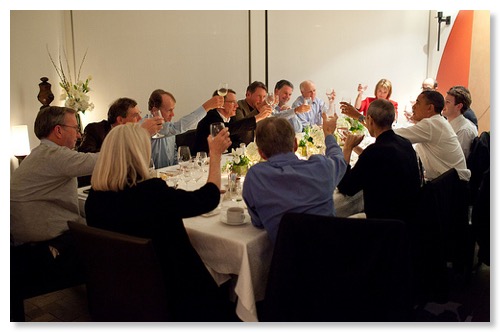
Last night, President Obama had dinner in Silicon Valley with several local CEOs and VCs as shown above. Fresh from his Saturday Night Live appearance Mark Zuckerberg was one of the guests.
Oddly, I wasn’t invited even though I was just in the area last week. We do not know what was discussed other than the official statement statement dealing with “proposals to invest in research and development and expand incentives for companies to grow and hire, along with his goal of doubling exports over five years to support millions of American jobs.”
But if I was a Silicon Valley CEO or VC here is what I would have politely told the President. Capital formation for R&D in innovative wireless technologies that need nonroutine approvals, e.g. rulemaking action, is being inhibited by the FCC’s long term inability to resolve such questions on a predictable schedule or a schedule that move anything like “Internet speed”. John Muleta, former chief of FCC/WTB spoke at my Virginia Tech class recently and used the following chart comparing new technology approvals with corporate merger (“M&A”) approvals. Both are complex and difficult.
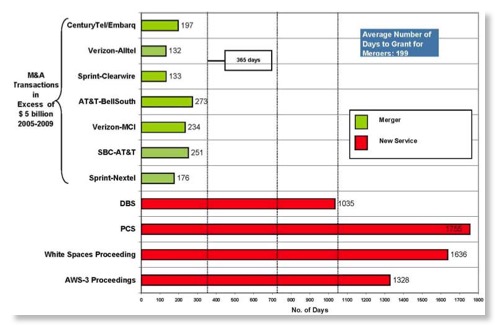
While new technology approvals theoretically are governed by Section 7 of the Communications Act, shown at right, for almost 30 years now the Commissio
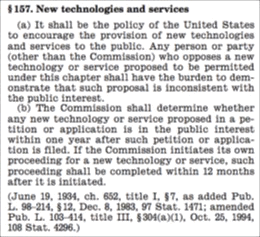
This week the White House proposed The Wireless Innovation (WIN) Fund to provide $1.0 billion to NSF over the next five year for research on experimental wireless technology testbeds, more flexible and efficient use of the radio spectrum, and cyber-physical systems such as wireless sensor networks for smart buildings, roads, and bridges as well as $15.0 million in FY2012 for Enhancing Access to the Radio Spectrum (EARS) that will support research into new and innovative ways to use the radio spectrum more efficiently. The papers I read indicate that generally the federal government is not looking for new spending opportunities and any such spending would be more effective if there were similar private investment - the very thing that is inhibited by FCC’s poor track record in resolving new wireless technology issues.
Alcatel-Lucent Tries a New Approach to the Cellular Tower Issue:
Hiring Engineers, not Lawyers
In a recent court filing CTIA stated,
Wireless technology – especially the advanced wireless broadband technology that is currently driving the infrastructure needs of wireless service providers – generates enormous benefits for businesses, consumers, and the economy as a whole, and is making important contributions to public safety. For that technology to achieve its potential, however, wireless service providers must be free to build their networks across the country.
What does the industry mean by “ must be free to build their networks “? In a recent article in a trade magazine, a major antenna manufacturer stated,
“In order to obtain the necessary site leases, landlords often want specific antenna locations or insist on identifying the locations themselves. These decisions are often made with minimal or no system engineering information and are sometimes based on purely aesthetic concerns: what location looks the best, or “I don’t want to be able to see the antennas from the street.” When antenna placement decisions are made in this manner — without proper engineering input and review — and then locked in through the site lease, there is often trouble ahead.”
Thus the viewpoint is that the first issue of base station design is the operation of the base station and the convenience to its designer. “Aesthetic concerns” appear to be topic for wimps.
Your blogger is proudly a “card carrying” engineer, yet he cringes at the sight of towers that “look like they were designed by engineers”. Good engineering is not only building systems that work, it is building systems that fit practical constraints like costs and compatibility with their location. Is neighborhood uglification a necessary part of our wireless future or is it a result of industry inattention in most cases?
Lest you think that this is the view of an eccentric consultant outside the mainstream, let me give you two quotes from mainstream industry players on the status quo of tower design. Previously I reported about the comments of Bechtel VP Jake MacLeod, at a 2009 FCC broadband hearing when he stated that “we have reached the end of the line for current design concepts (for cellular towers).” (Bechtel is a major builder of wireless infrastructure.)
In the past 2 weeks, Alcatel-Lucent has posted a video by Dr. Wim Sweldens, President, Alcatel-Lucent Wireless Division, a major industry supplier:
Before going into the technology he discussed, here is what this mainstream industry player has to say about the status quo:
Now clearly Alcatel-Lucent is trying to sell their new technology that has little or no field experience at this time. But I am proud of my alma mater, Bell Labs, for taking on this major design challenge to develop creative ways of building base stations without ugliness and even save energy at the same time. Let’s hope that the industry now objectively evaluates this and other new approaches to buildout rather than focusing excessively on legal battles.But we also have to be honest that in the mobile industry we are creating some problems. The mobile industry is actually contributing a fair amount to pollution...The mobile industry is also obstructing and cluttering our landscapes and cityscapes with more and more and bigger and bigger and uglier and uglier antennas and towers.
And why is that?We as the equipment vendors are part of the problem. We create big hungry base stations that need to become bigger and hungrier as we add more technologies. We put big towers with antennas and more and more of them every day. And that model and those types of technologies can not continue as our industry grows....
We have discovered the capability of taking these power hungry base stations and take these big and ugly antennas and pretty much make them invisible.
Remember what Tip O’Neill, Chmn. Ferris’ mentor said, “All politics is local” - the basic reason why pressing local governments on zoning is a hard battle that is best avoided - even by multibillion dollar industries.
More detailed discussion of lightRadio technology:
Enforcement Bureau Jammer Initiative
The above text and poster appeared on the FCC website last week as part of a multimedia offensive against illegal jammers. This offensive included an “Enforcement Advisory for Users”, an “Enforcement Advisory for Retailers and Manufacturers”, a news release, a web page on jammer enforcement, a blog on jammer enforcement, and even a Twitter feed on jammer enforcement!
Readers may recall that FCC foot dragging on enforcement of existing jammer rules and laws has been a recurring theme here and the subject of a recent FCBA talk by your blogger. (By contrast, your blogger disagrees with mainstream thinking within the cellular industry on whether the FCC could authorize limited jamming in prisons and on the meaning of Section 333 of the Communications Act.)
The EB “Jammer Enforcement” lists 68 enforcement actions against jammer since 10/04 - impressive at first look. However, a little analysis shows what is really happening here. Only one of these involved a fine (“NAL” in FCC jargon). That involved the appropriately named Phonejammer.com . In this case FCC issues a citation to the company on May 22, 2008 and issued the NAL on April 20, 2010 - 698 days later! It is unclear if Phonejammer.com ever paid the NAL or just morphed into another corporate identity.
The only other fines on the list going back to 2004 are also telling. They both involve Rocky Mountain Radar, a manufacturer of police radar jammers. The 8/14/07 Forfeiture Order has this explanation:
On January 31, 2007, the Spectrum Enforcement Division issued a Notice of Apparent Liability for Forfeiture ("NAL") in the amount of $25,000 to RMR. RMR has not filed a response to the NAL. Based on the information before us, we affirm this forfeiture.
Thus RMR did not even bother responding to FCC/EB! I suspect other jammer sellers will get the message here. A review of the RMR website seems to indicate that similar products are still being sold and they are still selling manuals for the models listed in the citation.
Thus not withstanding the new tweets and blog posts, there is nothing here that would really scare a firm intent upon selling either cell phone or GPS jammers. More puzzling than the FCC/EB inaction on the jamming issue is why CTIA and NAB condone the ineffectual enforcement. CTIA seems more concerns about keeping strictly regulated jamming out of maximum security prisons in rural areas where they could save lives than in keeping wantonly illegal jammers out of the market.
What is needed in jammer enforcement is not tweets about noncredible enforcement, rather some real enforcement! Let me repeat my call from the January FCBA talk:
- Incumbent spectrum users need to work together to advocate an effective compliance/enforcement program at FCC
- Recommend major trade groups form a compliance/enforcement advocacy consortium
Qualcomm Announcement of New OFDM Technology for Many Applications Including Wireless Mics
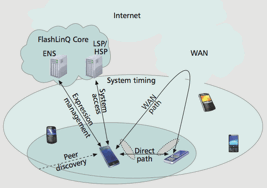
Qualcomm states,
FlashLinq advances a concept known as proximal communications, whereby users can continuously connect, disconnect and communicate directly with other mobile users at broadband speeds based on their physical proximity. The technology is designed to complement traditional cellular-based services and serve as a scalable platform for new types of applications.“By expanding the operator model of managed services to the frontier of proximal communications, Qualcomm continues to demonstrate its leadership in wireless technology and innovation” said Ed Knapp, senior vice president of business development and engineering for Qualcomm. “FlashLinq’s direct discovery and distributed communications allows operators to naturally extend their cellular networks. The technology can efficiently support new and enhanced services in areas such as direct local advertising, geo-social networking and machine-to-machine communications.”
While wireless mics are not a large market product, their presence in TV spectrum with their present technology severely limits new spectrum options for this “beachfront property”. It is not just that wideband FM is not spectrally efficient - the same reason it is being phased out for Part 90, but the present equipment is very susceptible to intermodulation interference - remember NEXTEL/public safety? - and the only way to avoid it is to scatter wireless mic channels across large swaths of spectrum - limiting its use. Just as a trace of oil can contaminate a large amount of drinking water, a few wireless mics with FM can deny huge amounts of spectrum to other users. Wireless mics need and deserve spectrum access, but not the present access which may be unique in major industrialized countries.
When analog NTSC was the TV technology, its quirks resulted in such low spectrum use that wireless mics were not a problem. But with today’s demand for spectrum, the low density use limitation of wireless FM is getting to be a major burden for those who covet the spectrum - be they the CTIA crowd (Qualcomm’s traditional customer base) or the Silicon Valley-based TWBD advocates.
Now that an alternative wireless mic technology has a major player behind it, we hope that FCC and people interested in UHF spectrum start pressing harder for an orderly phase out of wideband FM except for small users who need only a handful of audio channels, e.g. small churches, conference rooms, MCs at weddings, etc.
Great Action on Cleaning Up Anachronistic FCC Procedural Rules
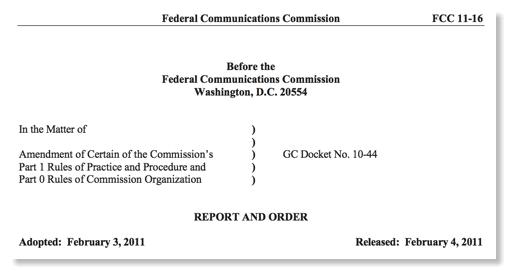
We determine that these revisions ... will increase the efficiency of Commission decision-making, modernize Commission procedures for the digital age, and enhance the openness and transparency of Commission proceedings for practitioners and the public.
While I was critical of FCC and OGC in the ex parte R&O of a few days ago, Friday’s Parts 0 and 1 procedural reforms are long overdue removals of anachronisms that previous leadership have ignored. When Chairman Hundt put in place the Commission’s website in the 1990s it was probably a progressive leader among administrative agencies - now it is an anachronism of clutter, hard to find information, and missing information due to lingering paper filing requirements. The new action removes most of these problems in one stroke.
First, the R&O will increase the use of docketing so more FCC proceedings will be online (para. 5-12). For example, your blogger’s ex parte complaint against a certain party has no trace at the FCC website except for its listing (for almost a year now) on the Items on Circulation page. As a result of these changes and the one in the recent ex parte rulemaking such proceedings as well as others will now have greater transparency.
(The only downside for this major surge in the use of dockets is that bloggers will no longer be able to use the total number of dockets opened in a year as a measure of Commission productivity. But we will find new ways to measure productivity!)
The R&O also removes many paper filing requirements and promises more at a later date (para.13-18). It appears that petitions for rulemaking must still be filed in paper form but hopefully that is on the list for later change.
Finally, the R&O requires that filings generally be in a machine searchable form:
Therefore, consistent with the goal of expanding the ability of interested parties to examine and test information that has been submitted to the government,60 we believe that electronic filings with the Commission should be machine readable whenever technically possible. In particular, filings containing text should be submitted in a format conducive to electronic search and/or copying, such as a Microsoft Word document or an Adobe .pdf copy. Similarly, filings containing non-text information should be submitted in native format such that, for example, third parties can sort the spreadsheet data within a filing using Microsoft Excel or similar programs. In cases of attachments exceeding 500 pages, information to be submitted in a format that does not permit electronic filing, and other exceptional circumstances, we will consider a waiver of the electronic filing requirement on a case-by-case basis, similar to the approach taken in our contemporaneous order reforming our ex parte rules. Finally, filings submitted to ECFS in .pdf or similar format should not be locked or password-protected.
Non searchable documents are a pain for both the FCC staff and other parties in a proceeding since it is harder to digest their contents in summaries and reply comments.
In preparing for a class this week, I came across a useful “Admin Law for Dummies”-like website that included the following observation
Don’t Protect Your Document: This may not occur to you - agency staff will set on your argument like hungry ferrets, summarizing and digesting it, and reporting the results to working groups. This is frequently achieved by our friend "Cut and Paste." If you copy-protect your document, you make it hard for the staff to work with it. And if you make it hard for the staff to work with your 40 page comment, and they have 300 more comments to read, what do you think will happen?
FCC is now following this advice and making it almost mandatory.
Congratulations, OGC, on a good R&O!
FCC Releases ex parte Report & Order
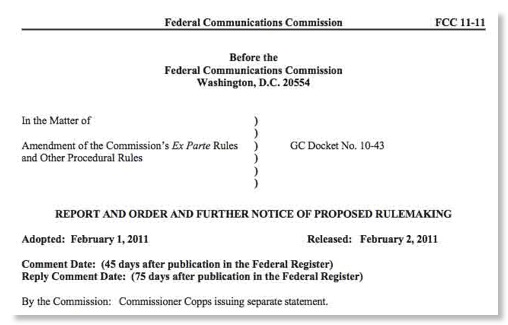
Yesterday FCC released the above Report and Order amending its ex parte rules, a frequent topic in this blog.
Here are the basic results in this rulemaking:
• Ex parte notices will be required for all oral ex parte presentations in permit-but-disclose proceedings, not just for those presentations that involve new information or arguments not already in the record.
• If an oral ex parte presentation is limited to material already in the written record, the notice must contain either a succinct summary of the matters discussed or a citation to the page or paragraph number in the party’s written submission(s) where the matters discussed can be found. If an oral ex parte presentation includes new information, the notice must contain a summary of the new data and arguments presented.
• Notices for all ex parte presentations must include the name of the person(s) who made the ex parte presentation as well as a list of all persons attending or otherwise participating in the meeting at which the presentation was made.
• Notices of ex parte presentations made outside the Sunshine period must be filed within two business days of the presentation.
[Other changes affect ex parte presentation during the Sunshine period - the week prior to discussion at an open Commission meeting, if the rulemaking is not resolved on circulation as most now actually are. These changes will not be discussed here as they are less generally applicable.]
Your blogger’s comments in this rulemaking raised a number of issues, most of which did not fare well - but then again it is not clear if anyone fared any better except perhaps those who argued for the status quo. One proposal that made an impact was to require that ex parte complaints and their disposition be made public. In para. 66 the Commission agreed to do so ending the present “black chamber” practice.
My suggestion for increased enforcement penalties was acted on in a strange way. The R&O dismisses my suggestion that those found in repeated violation should be barred from oral ex parte presentations for a period. Apparently the Commission ignored the specific proposal that the penalty restriction only apply to oral presentations and thus rationalized that it would be inappropriate to ban a party from all participation:
Although it would certainly deter parties from violating the rules, routinely barring parties from further participation in Commission proceedings diminishes their ability to influence action from the Commission that would serve the public interest, and it would lessen the pool of knowledge and information on which to base our decisions.
They did agree to delegate authority to EB to levy fines in case of violations found by OGC.(para. 67) Is this the same EB that recently
let 2 different cellular jammer sellers off without any fine and did the same thing in 2009 for a GPS jammer seller? Is this the same OGC that hasn’t found a single ex parte violation in more than 30 years?
Finally, even though I am not a lawyer, I note that there is no legal reference in the R&O to where the Commission has jurisdiction to levy fines for this type of violation. The Commission’s legal authority for issuing fines stems from Sections 501 and 502 of the Communications Act. It is pretty clear that 501 doesn’t apply here and it is not obvious that 502 does either. (For nearly two decades FCC issued documents claiming that it could enforce the technical rules of Part 68 on CPE vendors while it actually lacked such legal authority. This might be a similar bluff.)
The Commission finally admitted in para. 71 that it is the only regulatory agency in the federal government that has implemented ex parte procedures requiring outside parties to document what was said - a basic conflict of interest. It rationalizes this unique position:
(O)ne agency’s procedural rules do not fit all, and we would be ill-advised to incorporate the ex parte rules of another agency without giving considerable thought to whether those rules would achieve the interests of administrative efficiency, procedural due process and transparency better than our own rules as amended today. From that perspective, we see no clear advantage to the suggestion by Marcus that Commission staff prepare and file ex parte notices. Other agencies may be differently situated to the extent their docket is primarily adjudicatory rather than rulemaking (e.g., the Federal Trade Commission). Also, staff summaries raise an issue of fairness. The complex legal and technical nature of the issues sometimes presented ex parte make it preferable for the parties arguing those issues to summarize them.
So FCC thinks it is the only regulatory agency with a predominantly rulemaking (vice adjudicatory, e.g. enforcement and license award) docket load?
Does FCC think that the docket load at FAA, EPA, and the Nuclear Regulatory Commission are less technical than theirs?
Did FCC consider that even if the staff summarized what was said they could include in the docket handouts from the private parties on esoteric technical issues? The real benefit of staff summaries is the people writing them do not have the incentive to cover up issues so people with other views are kept in the dark. Thus if the submitted handout fairly summarized what was discussed, the staff could simply affirmatively so state. They could also add other issues that came up and points that were not candidly summarized in the handout.
Interior Implements White House's Scientific Integrity Policy:How About FCC and NTIA?
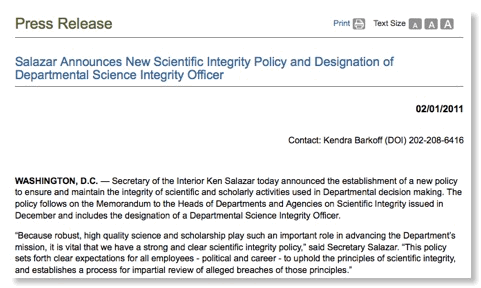
Washington Post columnist Ed O’Keefe published an article today about the Department of Interior’s implementation of the White House’s scientific integrity policy which has been a recurring theme here.
This policy states
The public must be able to trust the science and scientific process informing public policy decisions. Political officials should not suppress or alter scientific or technological findings and conclusions. If scientific and technological information is developed and used by the Federal Government, it should ordinarily be made available to the public. To the extent permitted by law, there should be transparency in the preparation, identification, and use of scientific and technological information in policymaking. The selection of scientists and technology professionals for positions in the executive branch should be based on their scientific and technological knowledge, credentials, experience, and integrity.
Now, a lot of the FCC’s jurisdiction is nontechnical - think of the famous ‘wardrobe failure” - and even some of the technical jurisdiction in spectrum management involves trades between costs of new service with respect to technical impact on existing spectrum users and benefits of the new service. But in spectrum policy I am reminded of what a distinguished telecom lawyer once told me, “Some questions actually have (objective) answers”.
For example, as FCC and NTIA tool up for a battle over LightSquared’s ATC application, it will be very tempting for opponents of it to just say that it will cause GPS interference inevitably. Now a poorly designed MSS/ATC system in the band adjacent to the GPS L1 signal will clearly cause interference just as a poorly designed TDD AWS-3 system next an FDD AWS-2 system will cause interference. But the key policy issue is whether clever engineers can come up with a set of design details to reduce this interference to an acceptable level comparable to naturally occurring outages. This should be considered in the context of the above quote from the White House, not in smoke filled rooms without the potential for objective review of the analysis - unless it is necessary to keep certain details of the public record to protect properly classified information. But even in that case, FCC or NTIA could ask for an independent review by a contractor with clearances or could set up a technical advisory committee with cleared members similar to the Defense Science Board.
There is anecdotal evidence within FCC that the famous FleetCall waiver that allowed the creation of NEXTEL and the resulting 800 MHz interference to public safety was identified by the technical staff of WTB’s predecessor as having an interference risk and that the staff urged an explicit condition on the waiver. We now know what happened when the waiver was granted without this condition. Had a scientific integrity policy been in place at that time, the resulting public safety interference could have been resolved quickly.
So why don’t FCC and NTIA emulate the progressive move by Interior in implementing the President’s scientific integrity policy!
[Your blogger has no financial interest or relationship with LightSquared]





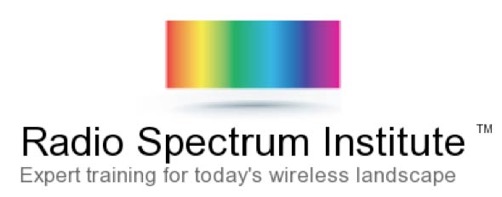


![Validate my RSS feed [Valid RSS]](valid-rss-rogers.png)

